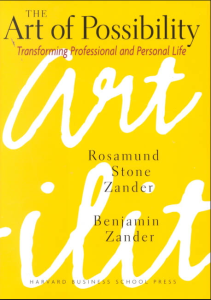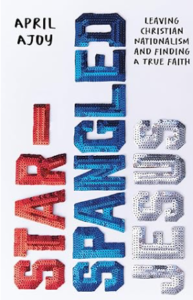 “Draw a different frame around the same set of circumstances and new pathways come into view,” say authors Rosamund Stone Zander and Benjamin Zander in their book The Art of Possibility: Transforming Professional and Personal Life. This brought to mind one of my favorite quotes by the late Wayne Dyer, ““If you change the way you look at things, the things you look at change.” I like this philosophy, and I wanted to read more.
“Draw a different frame around the same set of circumstances and new pathways come into view,” say authors Rosamund Stone Zander and Benjamin Zander in their book The Art of Possibility: Transforming Professional and Personal Life. This brought to mind one of my favorite quotes by the late Wayne Dyer, ““If you change the way you look at things, the things you look at change.” I like this philosophy, and I wanted to read more.
The Art of Possibility is full of examples to emphasize that life works better when you have a positive mental outlook. The authors tell a story of two shoe factory salesmen exploring new markets in Africa. After assessing the situation, both send telegrams:
SITUATION HOPELESS. STOP. NO ONE WEARS SHOES.
GLORIOUS BUSINESS OPPORTUNITY. STOP. THEY HAVE NO SHOES.
“The one who sees no shoes, all the evidence points to hopelessness. To his colleague, the same conditions point to abundance and possibility,” say the Zanders. Through easy to understand examples like this the authors drive home their point. I also liked the stories the Zanders share from their professions. Benjamin Zander is the conductor of the Boston Philharmonic Orchestra. Rosamund Stone Zander (nickname of “Roz” in the book) has a private practice in family therapy.
The Art of Possibility is more than just pie in the sky optimism. The Zanders recommend a realistic approach to negative thoughts and feelings. Their approach “doesn’t mean you should drown out your negative feelings or pretend you like what you really can’t stand. It doesn’t mean you should work to achieve some ‘higher plane of existence’ so you can ‘transcend negativity’,” they feel. “It simply means, being present without resistance: being present to what is happening and present to your reactions, no matter how intense. The capacity to be present to everything that is happening, without resistance, creates possibility.”
Reading the book led me to challenge some of my limiting beliefs. “We can replace the narratives that hold us back by inventing wiser stories, free from childish fears, and in doing so, disperse long-held psychological stumbling blocks,” say the Zanders. Perhaps our interpretations of the events in our lives do not match reality. “We see a map of the world, not the world itself,” the authors feel.



